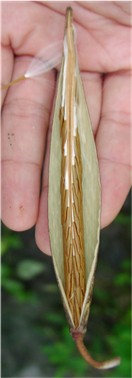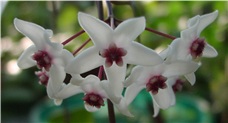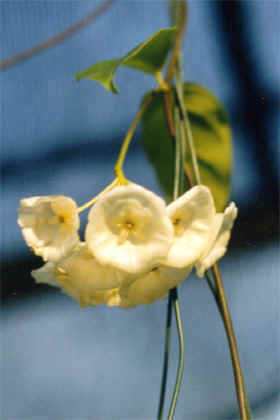Hoyas
I
It is probably
necessary to at least provide a basic defination, if you will, of what a Hoya
is. In general, they are tropical vines and more rarely, weak scrambling
shrubs that more often than not, oozes thick white sap when cut and produce
flowers that feel and look like plastics - hence the attraction. They belongs to
Asclepiad family, where more common garden plants like Stephanotis floribunda
and Stapeliads are also placed. Geographic distribution range from India,
Himilayan foothills to tropical SE Asia, N. Australia, New Guinea and some
Pacific Island, reaching the eastern limit at New Caledonia.
Hoyas have
very pretty waxy flowers often very fragrant. Growing them however, can be
rather tedious - as these are vining plants that can be quite vigorous when the
conditions are right. Constant pruning to keep them presentable is a must -
otherwise, they may be mistaken for weeds - like my dad who had inadvertently
disposed of some of my prized specimens when he came over to
"help". eafw
 |
Propagation
is usually via stem cuttings, where the 2 or more nodes are allowed to
contact the growing medium, usually an open substrate which retain a
little moisture like tree bark, coconut husks, crushed fern bark or
artificial materials like perlite.
Natural seed setting is
usually not very common but in my nursery in Singapore, species like H. verticiliata,
lacunosa and kerri (left) have done so. The seed pods contain many tufted
seeds which are dispersed by air. Germination rate is high but few
seedlings survive to maturity if left on their own in my nursery. |
|

|
H.
paziae is a native of The Philippines. It is a rather untidy shrubby plant
with dark green shiny acuminate leaves. The flower is very exquisite
and fragrant. |
|

|
Hoya
kerri - the sweet-heart vine from Northern Thailand, which have thick
heart-shaped leaves. This is not a balcony subject due to its large
size (10 metres or more) and requirement of strong sunlight to grow
well. During May to June (in Singapore), mass flowering can occur
for larger specimens. The flowers often lasts for more than one week. |
|

|
H.
nicholsoniae, F. Muel is a fast growing vine with pretty veined
leaves and strongly scented bloom. There appear to be many forms of
this species throughout Australasia and Indonesia and many different names
have been liberally applied. According to D.J. Liddle and P.I. Forster
(1992), H. pottsii, H. hellwigiana and H. sogerensis are conspecific. eafw |
|

|
Hoya
pachyclada is a close relative of nicholsoniae and has similar flower. In
habit, however, it looks like a desert succulent with thick leaves and
very thick stem. It grows slowly and sporadically - sometimes not growing
for almost a year and then flowering out of the blue. eafw
eafweafw
|
|

|
The
cup-shaped flowers of Hoya campanulata look and feel like plastic. The
wiry stem is dark and hairy and the internode long. This species is found
in lowlands of Malaysia, Borneo and Sumatra, especially along rivers.
This plant require wet, shady conditions and its cuttings is
tender, ie it does not ship bare-rooted very well at all. A similar plant previously known by the name of Physostelma wallichi
is believed to be another species by Christine Burton. |
|

|
H.
diversifolia collected from Pahang. This is a large rampant
"die hard" vine. It seems to grow non-stop if the nutrients and
light is sufficient. It is commonly observed in coastal swamps to open
areas in forests, and I have seen a great many crowding the branches of
mangroves in Singapore. |
An article
I wrote in Nature
watch
Go
back to main
Next Hoya Page






